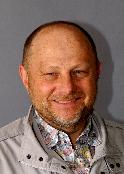Physical and Theoretical Chemistry
 Light, chemistry and photophysics are the most natural and
cooperative of partners. The energy in a single particle (photon) of
visible light is just that amount needed to perform chemical
transformations. Nature takes complete advantage of this synergy in
the amazingly efficient yet complex process of photosynthesis.
Photosynthesis is the driving force for life on our planet.
Light, chemistry and photophysics are the most natural and
cooperative of partners. The energy in a single particle (photon) of
visible light is just that amount needed to perform chemical
transformations. Nature takes complete advantage of this synergy in
the amazingly efficient yet complex process of photosynthesis.
Photosynthesis is the driving force for life on our planet.
Spectroscopy delves into the subtle yet absolutely distinctive interactions of light, both visible and invisible, with the many forms of matter. Usually, light can be either absorbed, emitted or just scattered. By using lasers with their special properties, other far less familiar processes become possible. The wide range of spectroscopic techniques now available may be utilised as either analytical or diagnostic tools, right down to the extreme limit of chemistry – measurements on single molecules.
When applied at the more fundamental level, spectroscopy provides potent methods with which to probe the innermost secrets of all chemical species. Spectroscopy also maps out the detailed electronic structure of all the different forms of matter. This information is critical to the understanding of both chemical bonding and chemical reactivity.
Laser technology continues to evolve and in the process revolutionise spectroscopy. Laser light is very different to ordinary light (sunlight or lamplight, etc.). Lasers can consist of a single, pure colour, to a precision better than one part in a billion. Light pulses can be compressed into incredibly short pulses or amplified to a point where the very distinction between light and matter becomes blurred. Put simply, lasers induce processes to occur that are just not seen with “ordinary” light sources.
Our group performs spectroscopic measurements on a wide range of materials and systems: organic and inorganic, molecular, ionic, amorphous, crystalline, and now dominantly, biological. Our great strength is the ability to design, develop and invent special experiments and apparatus to accurately target questions of fundamental importance. For example molecules may behave quite differently in solution to when ‘trapped’ in a protein or crystal. These critical environmental influences may be probed via laser selective spectroscopy.
Our work with Photosystem II continues to grow, widen and flower. During the year, Prof. Elmars Krausz was invited to speak on this at the Boden Research Conference on Artificial Photosynthesis in Sydney, the DPC meeting in Christchurch and the ACOLS meeting in Melbourne. He also presented the group’s work at the Gordon Conference on Photosynthesis in New Hampshire as well as giving seminars at Stanford, California and Ames, Iowa. Dr. Barry Prince and Mr. Joseph Hughes also presented their work at the DPC and ACOLS meetings. Mr. Lesley Debono spoke at the Student Conference on Physical Chemistry in Albury.
An ARC Linkage grant was won this year, in partnership with the Australian laser and spectroscopy company Lastek and the University of Queensland to fund a PhD scholarship looking to develop control and analysis software of our ARC LEIF funded new generation metallo-enzyme magneto-optical spectrometers.
Visitors to the group this year included this year’s Frew Fellow, Professor W.E. Moerner from Stanford University. ‘W.E.’ and his collaborators were the first to report optical spectra of single molecules or ions in the condensed phase. A visit by Professor J.H. Choi from Andong University in Korea was funded by a Joint Australian/Korean program through the Australian Academy of Science, to use our single crystal spectroscopy expertise on a range of chromium complexes.
The research highlight of the year was that PSII core complexes undergo extremely efficient spectral hole-burning at low temperatures. This process occurs in both the ‘open’ quinnone oxidized state of PSII and also in ‘closed’ state. Burn characteristics are very different to those seen in inactive PSII and related systems. The homogeneous linewidth seen indicate that the most fundamental process and key process in PSII, charge separation of P680, may be orders of magnitude slower that previously thought! (with B. Prince, J. Hughes, and R. Pace, P. Smith [Chemistry, ANU], H. Riesen [UNSW College at ADFA])
Enormous efforts have been made to crystallize photosynthetic reaction centre proteins for X-ray structures. Little has been done on their optical spectra. We have made encouraging measurements on both PSII crystals and bacterial reaction centre crystals. We look to take advantage of the improved resolution and polarization data available from such measurements. (with S. Peterson, R. Pace, P. Smith [Chemistry, ANU], M. Parker[SVIMR], J.R. Shen [Riken Harima Institute, Kyoto Japan], R. Baxter [U. Chicago USA])
The role of the tightly bound and strongly conserved Cyt b559 haeme in PSII has long been a mystery. We are performing new spectroscopic measurements to quantify its spectroscopy and photochemistry. We have already been able to resolve spectral detail not previously seen. (with S. Peterson, L. Debono, R. Pace, P. Smith [Chemistry, ANU])